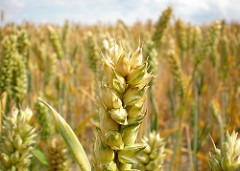
GM/Biotech Crops Report – August 2017
7th August 2017- GM/Biotech Crops Monthly Reports (BELOW) form part of BCPC’s free three-tier Biotech Crops Info service.
- This service also includes a weekly round-up of news from around the globe – see BCPC Newslink GM Crops section.
- Plus – Free access database on over 300 GM/biotech products covering 23 crops in the global market visit BCPC’s GM/Biotech Crops Manual – Register here for free access.
Already registered? Click here
GM/Biotech Crops Monthly Report August 2017
 |
Vitamin A-rich chickpea Golden rice is famous for boosting vitamin A availability in areas where deficiency causes eye defects and now a PhD student at Saskatchewan University has developed a chickpea with enriched vitamin A content. Besides improving sight it is also claimed to enhance brain function, improve skin health and slow down aging! More |
|---|---|
| Purple Weetabix anyone?
Chinese scientists have produced a strain of rice with purple grains because it contains high levels of the anti-oxidants beta carotene and folate. The benefits of folate to pregnant women and the anti-oxidant properties of beta carotene are well-known and these researchers hope to develop other cereal crops with enhanced anti-oxidant properties: More |
 |
 |
Improved cassava
Cassava is one of the staple foods of Africa and now a strain has been developed with enhanced nutritional qualities and resistance to cassava Mosaic virus and Brown Streak disease. More
|
| Improved nitrogen-fixation in alfalfa
Over-expression of the gene MiR156 in alfalfa results in plants with delayed flowering, longer roots and improved yield. The effect is due to improved nitrogen fixation and the technique may be applicable to other legumes. More
|
 |
 |
Now Golden bananas!
Golden rice and vitamin A enriched chickpeas are mentioned above but now a group at Queensland University in Australia have developed bananas with enriched pro-vitamin A content. Since cooking bananas are an important food crop of Uganda, it is destined to improve the health of young Ugandans once approved in 6 years time! More |
| Powdery mildew-resistant tomatoes
Powdery mildew colonisation of tomatoes is facilitated by the SlMlo1 gene and suppression of this gene occurs naturally in tomatoes with ensuing lowered susceptibility to powdery mildew. Crossing this trait into commercial varieties is tedious and slow but now scientists at The Sainsbury Laboratory in Norwich have achieved the transfer using CRISPR-Cas9 editing. More |
 |
|
|
Imazadolinone-resistant borage
The health benefits of the gamma linoleic acid found in borage have caused it to be grown commercially but herbicide development has lagged behind. Now a tean at Saskatchewan University have developed a line that tolerates up to 4 times the field rate of imazadolinone herbicides. More |
| Reduced lodging risk (and height) in rice
Extensin proteins are associated with cell growth and development and a team in China have identified an extension-like gene in rice. When subjected to two different promoters it causes the cells to become less elongated and with thicker side walls, thus reducing the risk of lodging: More |
 |
 |
Tomatoes fight back!
Methyl jasmonate causes tomatoes to produce toxins that make the leaves less nutritious to leaf-eating caterpillars of the small brown willow moth. Deprived of sufficient food, the caterpillars start to eat each other! More
|
| Wheat blast risk
Wheat is normally resistant to wheat blast disease but there was an epidemic in Bangladesh recently probably caused by the arrival of a South American strain of the disease. A mutation in just one gene allowed it to escape recognition by the wheat and knowledge of this weakness should help target the development of wheat varieties with more durable resistance: More |
|
THE LATEST ADDITIONS TO THE GM/BIOTECH DATABASE ARE:
- New stacked event – MON87427 x MON89034 x TC1507 x MON87411 x 59122 x DAS40278 – maize with tolerance of glyphosate, glufosinate, 2,4-D and resistance to coleopteran and lepidopteran insects approved for food, feed and cultivation use in Canada.
- New stacked event – MON89034 x TC1507 x NK603 x MIR162 – maize with glyphosate and glufosinate tolerance and resistance to Lepidopteran insects approved for food, feed and cultivation in Argentina and Canada.
- New stacked event – Bt11 x MIR162 x MIR604 x MON89034 x 5307 x GA21 – maize with tolerance of glyphosate and glufosinate and resistance to lepidopteran and coleopteran insects approved for food, feed and cultivation use in Japan and Canada.
- New stacked event – 3006-210-23 x 281-24-236 x MON88913 x COT102 x 81910 – cotton with tolerance of glyphosate, glufosinate and 2,4-D herbicides and resistance to lepidopteran insects approved for food and feed use in South Korea.
- 3006-210-23 x 281-24-236 x MON88913 – Cotton with tolerance of glyphosate and glufosinate and with resistance to lepidopteran insects approved for food and feed but not cultivation uses in the European Union.
- GHB119 – Cotton with tolerance of glufosinate and resistance to lepidopteran insects approved for food and feed but not cultivation uses in the European Union.
- BT11 x 59122 x MIR604 x TC1507 x GA21 – maize with tolerance of glyphosate and glufosinate and with resistance to coleopteran and lepidopteran insects approved for food and feed but not cultivation uses in the European Union.
- DAS40278 – maize with 2,4-D herbicide tolerance approved for food use in Taiwan and for food and feed but not cultivation use in The European Union.
FOR INSTANT ACCESS TO GM BIOTECH MANUAL CLICK HERE (Registration required)
Already Registered? Click here to access



